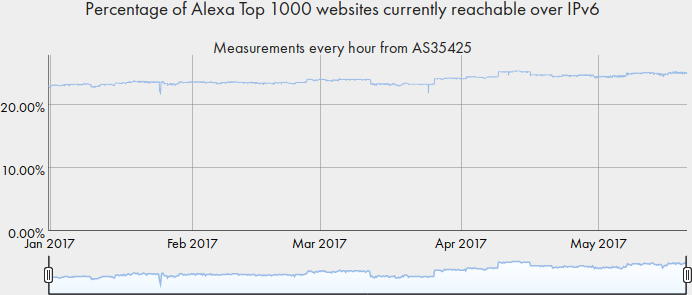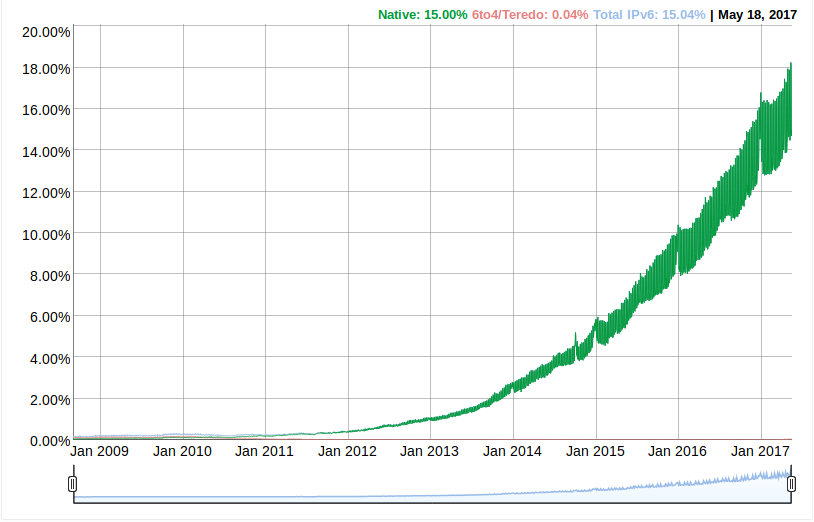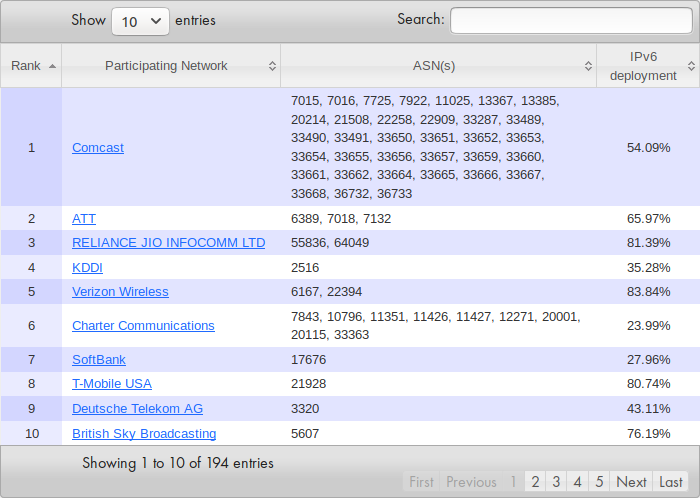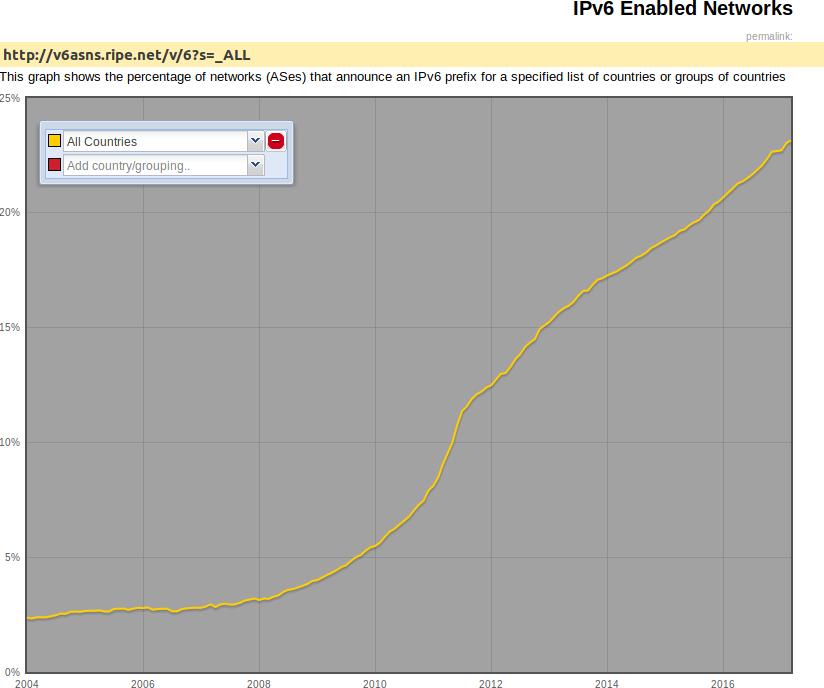IPv4 has served us well for the last 35 years. But in a world of already exhausted address space its future seems uncertain. Everyone knew it wouldn’t last forever. However, most ISPs didn’t start deploying IPv6 networks actively until the address pool got almost depleted. Why was that? Why it took so long to react? There are several reasons that explain it:
- Necessary period of time to implement the standard. The IPv6 proposed standard was published in December 1998, but it certainly takes a long period of time to implement and test a standard. Until it’s finally shipped in products it can pass several years. In the case of IPv6, it was also necessary to deploy pilot networks to test it in real environments. Operators needed time as well to learn how to work with the new technology. All in all, it’s fair to say that the decade that followed the publishing of RFC 2460 (“Internet Protocol, Version 6 (IPv6)”), was a period of time for experimenting, testing and learning.
- Lack of a clear benefit. Replacing IPv4 for IPv6 won’t result in a performance boost or more reliable networks. Users won’t notice the change. If things are working well, why bothering changing them? In addition, deploying an IPv6 network is not a trivial task. It often implies doing some sort of financial and human resource effort. For instance, if the network depends on legacy software or hardware that doesn’t support IPv6, it’s necessary to replace it. There are operational costs as well, since it’s necessary to maintain an additional network.
- Lack of incentive. Some governments encouraged the adoption of IPv6 by requiring to upgrade their networks. That was the case of the USA government which in 2005 defined a three year deadline to add IPv6 support to all the backbones of all their federal agencies. Other governments defined agendas but failed to fulfill them. Without demand from customers and lack of a clear benefit, ISPs didn’t take action to make the switch on their own initiative.
- Dependency on IPv4. IPv6 transition depends on carriers, governments, standards organizations, hardware manufacturers and content providers. It’s a distributed effort and it was known from the start the transition won’t happen simultaneously. For some period of time, IPv4 and IPv6 will have to co-exist. But we still depend on IPv4 today. It’s not only about content or connectivity, it’s about software too. For instance, Skype is reported to not work in IPv6-only environments (Skype 5.0 for Linux, announced two months ago, doesn’t feature that problem). Steam is another application which still depends on IPv4. Another infamous case is Windows XP which depends on IPv4 connectivity to perform DNS resolution.
Worldwide deployment status
Since IPv4 and IPv6 are disjoint networks, it’s not possible to reach an IPv4 server from an IPv6 client (unless our ISP provides some sort of bridging). According to Alexa, as for today 25% of the world’s top 1000 sites are reachable over IPv6.

Companies such as Google and Akamai provide statistics of IPv6 adoption status. Adoption is uneven worldwide, with countries such as Belgium (48%), USA (32%) and Greece (30%) on the top of the list of end-user connectivity.
In the case of the USA, mobile connectivity has helped a lot to increase IPv6 adoption, all thanks to operators such as Verizon. Unlike 3G networks, 4G networks are packet switching only. That means that voice services run on VoIP (voice over IP). Verizon mandates that all its 4G networks work on IPv6 only, deprecating IPv4 capability.
According to Google, 18% of the world’s Internet traffic today is IPv6.

Cable TV, which nowadays is delivered over IP too, has also helped a lot to increase IPv6 adoption. It’s not surprising to see companies such as Comcast, the largest cable television company in the world, ranking the top 10 of IPv6 network operator adoption.

It’s important to distinguish though IPv6 end-user adoption from network adoption. Network adoption is measured by counting the number of ASes (Autonomous System) that are IPv6 capable. On the other hand, end-user adoption is often measured by tracking IP requests on dual-stack websites (websites that are reachable either over IPv4 or IPv6). According to RIPE NCC, the number of IPv6 enabled networks worldwide is 23%.

That’s a global trend. Usually network adoption is higher than end-user adoption. There are several reasons for that. There are carriers which are IPv6 capable but are not allocating IPv6 addresses to their customers yet. Another reason is a carrier providing IPv4 services on IPv6-only networks. I will get into that later.
Transitioning to IPv6: efforts and challenges
Since IPv6 was proposed it was clear that the new protocol would need to live together with IPv4, at least for some period of time. The Internet is now more complex and distributed than when ARPAnet migrated from NCP to IPv4. This time the transition will happen much more gradually, at different paces in different countries.
For this reason, the scenario that everyone foresaw 10 years ago was Dual-Stack networks. A Dual-Stack network supports either IPv4 and IPv6 connectivity. IPv6 connectivity is preferred, but if a site or service is not available over IPv6, the customer falls back to IPv4.
In addition to Dual-Stack networks, there are a myriad of mechanisms that provide interoperability between IPv4 and IPv6. Usually these technologies involve some type of tunneling and translation. The possible scenarios are IPv4 connectivity over an IPv6-only network and IPv6 connectivity over an IPv4-only network or a combination of both. Here is a summary:
| Connectivity | Type of network | Transition technology |
| IPv4, IPv6 | Dual-Stack | None |
| IPv6 | IPv4-only | Tunnel broker/6in4, 6over4, 6rd, 6to4/Teredo, ISATAP, IVI/NAT64/SIIT |
| IPv4 | IPv6-only | Dual-Stack Lite, Light weight 4over6, MAP, 4in6, 464XLAT, IVI/NAT64/SIIT |
IPv6 connectivity over an IPv4-only network is an useful scenario to test and try out IPv6 without incurring in the costs and troubles of deploying an IPv6 network. Technologies that enable that are 6rd (RFC 5969 “IPv6 Rapid Deployment on IPv4 Infrastructures”). RFC 6264 (“An Incremental Carrier-Grade NAT (CGN) for IPv6 Transition”) is also an interesting proposal. Tunnel brokers/6in4 are useful if you’re interested in trying out IPv6 but your ISP hasn’t assigned you an IPv6 address yet. I discussed how to setup a tunnel broker with Hurricane Electric in this other blog post: IPv6 tunnel.
Translation between IPv6 and IPv4 and viceversa, also known as IVI translation, is another interesting mechanism. NAT64 (RFC 6052, “IPv6 Addressing of IPv4/IPv6 Translators”) is the most popular form of IVI translation and works in all the scenarios. NAT64 translates the headers of IPv4 packets to IPv6 headers, and viceversa. NAT64 deprecates SIIT.
Lastly, the other possible scenario is to provide IPv4 connectivity over an IPv6-only network. There’s an increasing interest in IPv6-only deployments. One of the disadvantages of Dual-Stack is maintaining two networks. However, since many services still depend on IPv4, operators need to provide IPv4 connectivity to their customers. IPv4 services can still be delivered over an IPv6 network by using tunnels and introducing some business logic in the carrier.
Some of the most popular IPv4-on-IPv6 technologies are 464XLAT and Dual-Stack Lite. In the next section I will cover the latter, but before that I need to discuss Carrier-Grade NAT.
Carrier-Grade NAT
For many years it was thought that the transition to IPv6 will be completed before the IPv4 address pool went totally exhausted. But the transition barely started a few years ago. ISPs now face an scenario where they need to extend the lifetime of IPv4. The proposed solution is called CGN (Carrier-Grade NAT), some times also called LSN (Large-Scale NAT).
But before diving in the underpinnings of CGN, let me explain how an ISP assigns public addresses to their customers.
Normally, service providers assign public IP addresses to their customers via DHCP. Each CPE (Customer Premise Equipment), also known as home gateway, receives a public IP address. Sometimes the ISP also exposes you a private IP network address (RFC 1918 “Address Allocation for Private Internets”), although generally is the user who picks a preferred private address. This private address is used within the customer’s private network, while the home gateway uses the public address to communicate within the carrier’s network. The CPE runs a NAT44 function to share its public address with all the devices within the customer’s private network. ISPs tend to lease public addresses to home gateways for a limited period of time. If the ISP detects a customer is inactive, it may try to reclaim its public address and put it back to ISP’s pool of public addresses.
Strictly speaking, a Carrier-Grade NAT is a NAT placed at the service provider’s network. The more devices a NAT can serve, the more useful it is. Normally a CPE’s NAT serves a limited number of devices, depending on the size of the customer’s network. A NAT performed at the carrier can serve multiple customer’s private networks, maximizing the use of public addresses.
Usually CGN involves a NAT444 scenario. Outbound packets from the customer pass through 3 different domains: the customer’s private network, the carrier’s private network and the public internet. To avoid address conflicts between the customer’s private networks and the carrier’s private network, the IETF agreed on reserving a /10 block called Shared Address Space (RFC 6598, “Shared Address Space Request”). The Shared Address Space address is 100.64.0.0/10.
CGN is not an IPv6 transition mechanism. It’s an approach to extend the lifespan of IPv4 addresses until a full migration is completed.
On the other hand, CGN has some important disadvantages:
- It introduces a centralized element in the network, which might cause bottlenecks and scalability issues.
- It makes impossible to host services in the customer’s hosts.
- Since different customers shared the same IPv4 public address, a website that bans a customer by IP might have consequences to other customers.
Dual-Stack Lite
Now we know about CGN. This is important as CGN is an important component of Dual-Stack Lite. But, what’s Dual-Stack Lite?
One of the inconveniences of Dual-Stack networks is maintaining two networks. That often means double operational costs as it’s necessary now to configure, provision, monitor, diagnose and troubleshoot two different networks. Wouldn’t be simpler to provide both IPv4 and IPv6 services over one single IPv6 network? Introducing Dual-Stack Lite.
Dual-Stack Lite, often referred as DS-Lite, provides IPv4 connectivity on IPv6-only networks. To do that DS-Lite relies on IPv4-in-IPv6 tunnels to provide IPv4 services. Tunneled packets reach an element in the carrier’s network called the Address Family Transition Router, which runs a Carrier-Grade NAT function. There are two elements that are fundamental for the deployment of DS-Lite:
- B4 (BroadBand Basic Bridging): It’s a network function that runs at the WAN interface of a customer’s CPE. The B4 function is responsible of encapsulating IPv4 packets into IPv6. The CPE should not run a NAT44 over the outbound packets since the NAT function is performed at the carrier.
- AFTR (Address Family Transition Router): Decapsulates IPv4-in-IPv6 packets and runs a CGN function over the packets. The AFTR keeps a binding table grouping together the CPE’s IPv6 address, IPv4 private address and TCP/UDP port. When an inbound packet reaches the AFTR external interface, the CGN undoes the NAT obtaining the associated IPv4 private address. Together with the destination port, both elements can be used to look up the B4’s IPv6 address. The AFTR encapsulates the packet and forwards it to the customer’s B4.
Compared to CGN over IPv4 networks, only one NAT is necessary in DS-Lite. The model encourages service providers to move to IPv6 guaranteeing continued support for IPv4 services.
However, DS-Lite has also some inconveniences. The AFTR must maintain per-flow state in the form of active NAT sessions. If an AFTR serves a large number of B4 clients, that may cause bottlenecks and scalability issues.
In the next article, I will discuss Light-Weight 4over6, a model based on DS-Lite but which tries to solve its shortcomings.
Please drop me a line if you have any feedback. Thanks!